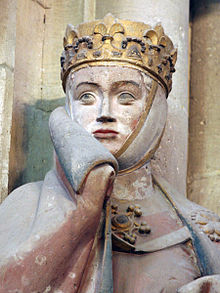Uta from Naumburg

The statue called Uta von Naumburg is one of the most important sculptural works of the German Gothic . The colored stone figure was created in the middle of the 13th century by the so-called Naumburg Master and is located in the west choir of the Naumburg Cathedral, separated by the rood screen . It is one of the twelve donor figures of an early chapel around which the new cathedral was built in the 13th century.
The figure
The sculpture is generally regarded as a representation of Uta von Ballenstedt (1000? -1046), the wife of the Margrave Ekkehard II of Meissen . Due to the crown, which is atypical for a margravine, and the way the coat is worn, this has recently been questioned.
Those who have died for over two hundred years at this time stand together in a semicircle as great, individually characterized personalities. The artistic language is the culmination of a development that began in Germany around 1200 and sought to overcome the stencil-like typicity of the Romanesque, above all by increasing individual characteristics, especially by moving the figures. All of this finds its culmination in the Naumburg donor figures. In addition to the idea, which was revolutionary for its time, of depicting not holy but secular persons in the special area of the choir, there is a new artistic form.
The path from the Naumburger Hütte can be followed as far as Meißen. Above all, the singular, completely new form of Uta became famous in art history as one of the most ingenious creations of German sculpture. The coat collar, which is pulled up to half the height of the face to protect it, is held from the inside by the right hand and from which long folds of the robe extend vertically down to the floor, while the left hand pulls the other part of the coat to itself as if to secure it creates a wonderful motif of movement, all of this was new as a psychological motif and suddenly brought a new basic mental situation into German sculpture: the noble woman seeking protection, who still radiates absolute sovereignty in the act of protecting herself.
The image of the margravine became of particular importance towards the end of the 19th century. In the time of the emerging photography and the publication of illustrated guides on German art history, the figure of Uta moved into a central position. One often overlooked their classification in the circle of the 12 donors (Gerburg, Konrad, Hermann, Regelindis, Dietmar, Sizzo, Wilhelm, Timo, Ekkehard, Gepa and Dietrich) and treated them as solitaires. Only she was trusted in broad circles by the founder figures. Their myth grew that way. Her admiration reached a climax during National Socialism , where she was stylized as an alleged expression of pure German sentiments and typical German feminine character. As clay figurines for private households, they were often hung up with the Bamberg rider , icons of the ideal of German men and noble German women.
Appreciation
Umberto Eco honors Uta von Naumburg in a very special way. In an interview for the Süddeutsche Zeitung he says: "If you ask me which woman in the history of art I would go out to eat with and spend an evening, there would be Uta von Naumburg first."
literature
Non-fiction
- Wolfgang Ullrich : Uta von Naumburg. A German icon. Wagenbach, Berlin 2005, ISBN 3-8031-2523-5 . ( Review )
- Helga Wäß: The wall sculptures in Naumburg Cathedral. Volume 2. In: Helga Wäß: Form and Perception of Central German Memory Sculpture in the 14th Century. Edition Tenea, Berlin 2006, ISBN 3-86504-159-0 , p. 467 ff.
- A contribution to medieval grave monuments, epitaphs and curiosities in Saxony, Saxony-Anhalt, Thuringia, North Hesse, East Westphalia and South Lower Saxony.
- Catalog of selected objects from the High Middle Ages to the beginning of the 15th century.
- Wolfgang Hartmann: From the Main to Trifels Castle - from Hirsau Monastery to Naumburg Cathedral. On the traces of the Franconian noble family of the Reginbodonen in the Middle Ages. Publications of the history and art association Aschaffenburg e. V. Vol. 52. Aschaffenburg 2004, ISBN 3-87965-098-5 .
- Folkhard Cremer: The anti-Staufer figure cycle in the Naumburg West Choir and why there is no Uta von Ballenstedt in it. In: The Minster. 51.1998, pp. 262-270 (different interpretation of the figure).
- Michael Imhof , Holger customer: Uta von Naumburg. Michael Imhof Verlag, Petersberg 2011, ISBN 978-3-86568-655-8 .
- Gerhard Straehle: The Naumburg donor cycle. Eleven donors and the slain in the west choir (synodal choir) of Naumburg Cathedral . (= The Blue Books ). Langewiesche publishing house, Königstein i. Ts. 2012, ISBN 978-3-7845-2960-8 .
Fiction
- Hanna Kiel : Uta von Naumburg. Narrative. Rembrandt, Berlin 1936.
- Rosemarie Schuder : The heretic of Naumburg. Historical novel. BS, Rostock 2005, ISBN 3-89954-133-2 .
- Felix Dhünen : Uta von Naumburg. Play in 3 acts. Bloch, Berlin 1934.
- Claudia Beinert , Nadja Beinert : The mistress of the cathedral. Historical novel, Knaur 2013, ISBN 978-3-426-51404-7 .
Web links
Remarks
- ^ Michael Imhof , Holger customer: Uta von Naumburg. Imhof, Petersberg 2011, ISBN 978-3-86568-655-8 , p. 58; Kerstin Merkel: New observations on the clothing of the Naumburg donor figures. In: Hartmut Prohm, Holger Kunde (ed.): Der Naumburger Meister - Conference proceedings for the state exhibition 2011. Imhoff, Petersberg 2012, ISBN 978-3-86568-742-5 , pp. 188–203, here p. 191, after which the The person depicted must have been perceived by contemporaries as a wicked woman because she wore her coat like a man. ( PDF )
- ↑ Espejo, espejito. January 22, 2008, Retrieved July 1, 2019 (Spanish).
- ^ Holger Kunde: The Naumburg Cathedral. Michael Imhof Verlag, Petersberg 2011, p. 26.

